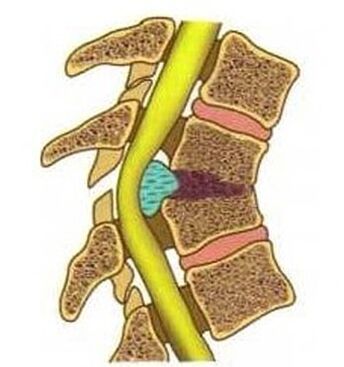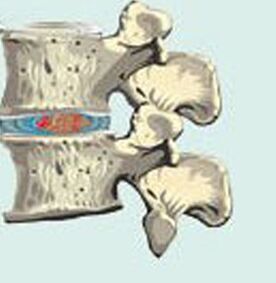Osteochondrosis is a degenerative-degenerative spinal disease, in which intervertebral disc damage in the form of its deformation, reducing height and stratification is observed. The manifestations of this pathology are diverse, but can be combined in various syndromes. Depending on the severity of symptoms, changes in intervertebral discs around their structures, various stages of osteochondrosis are distinguished. Before treating cervical region osteochondrosis, it is important to find out why several medications are needed physiotherapeutic and surgical methods.

general information
Cervical spine osteochondrosis develops more often in people over 35, but sometimes their manifestations are observed at 18 to 30 years. The cervical spine consists of vertebrae, most mobile devices are generally affected to Thursday, 6th, 7th.
Among the vertebrae are intervertebral discs, which are a special form of more durable cartilaginous bone connection. They provide the spinal capacity of the spinal to support significant loads and its mobility.
Each intervertebral disc consists of:
- POLPOEOSIS CORE (jacket), which is a gel -like mass.
- Dense fibrous ring around the core of the disc.
- Two fine white fibrous cartilage plates covering the top and below.
The intervertebral discs are connected to the vertebrae bodies using a ligament apparatus.
The causes of osteochondrosis
In people over 20, ships that feed intervertebral discs are covered with vegetation. In the future, these structures receive all the substances needed by diffusion from several arranged vertebrae, but usually these processes are insufficient for normal record metabolism.
Cervical spine osteochondrosis develops more often under the influence of:
- Hereditary predisposition.
- Anatomical anomalies of the cervical region.
- Overweight.
- A sedentary lifestyle associated with sedentary work, lack of physical effort.
- Trauma of the spine in the neck, including bruises, fractures.
- Metabolic disorders in the body.
- Age -related changes.
- Excessive physical exercise.
- Psycho stress -frequent emotional.
These factors exacerbate violated nutrition of intervertebral discs. As a result, the pulse core is flat, they become less elastic. The load in the fibrous rings increases, which is accompanied by stretching, the formation of cracks in them.
At the bottom of such degenerative changes, the intervertebral disk can project itself to the spinal canal. The irritation of the posterior longitudinal ligament rich in nerve endings is accompanied by local pain.

With the progression of the disease, there is a rupture of the posterior longitudinal ligament, the intervertebral disc is protruding in the cerebrospinal fluid, this condition is called hernia. At the same time, rooster syndrome is developing, caused by irritation of the nearest cerebral spine, local autoimmune inflammation. If the root blade artery is squeezed, the blood supply to the spinal cord will be disturbed.
Cervical spine osteochondrosis is accompanied by the formation of osteofit - consequences of bone tissue in bodies, vertebrae processes. These formations can also squeeze the roots of the spinal nerves or spinal cord.
The first signs
Osteochondrosis of the Cervical Thoracic Department at the early stage is accompanied by tension, quick fatigue of the muscles in this area. Subsequently, discomfort, nape pain, neck, shoulders, intensifying during inclinations, the heads of the head are joined.
Dizziness, headaches - other first signs of cervical osteochondrosis in women, men. Sometimes a person feels pain, a feeling of numbness, tingling in his hands after a night's sleep.
The main symptoms
Cervical spine osteochondrosis is more often characterized by:
- root syndrome;
- Vertebral Artery Syndrome;
- Cardiological syndrome.
Some people have reflex dystrophic syndromes, discogenic cervical myelopathy. Emotional disorders, panic attacks with cervical osteochondrosis are also often observed.
Rook Syndrome
The manifestations of root syndrome are caused by compression (compression) of the spinal nerve root of the hernia of intervertebral discs, the osteophytes of the bodies, the processes of the vertebrae themselves. As a result of compression of nerve fibers, a local inflammatory reaction is developed, which is accompanied by pain through the cold of the affected nerve.

Therefore, with cervical osteochondrosis, symptoms such as neck pain, hands, areas of the rear occurs. Unpleasant sensations can be observed in the heart, stomach. If neck pain remains constantly, intensifies when spinning, leaning out of the head, this condition is called cervicalgia. In addition, the pain may have the character of lumbago, give in to the hand, they are called service.
In areas that innervate the affected nerve, there is a pronounced decrease in sensitivity. The muscles in this area become weaker, their atrophy can be observed, which is accompanied by a decrease in their volume.
Vail Artery Syndrome
The vertebral artery is a paired blood vessel that provides blood supply to the brain at 15 to 30%. By squeezing the vertebral artery, various chronic manifestations of oxygen insufficiency in the central nervous system are observed by altered intervertebral discs, the growth of vertebrae.
In the development of this state, 2 stages are distinguished: functional, organic (ischemic). In the first of these, the main symptoms of vertebral artery syndrome with cervical osteochondrosis are frequent headaches. They become more pronounced in head movements as well as maintaining a position for a long time. The pain is sore or pulsating, felt in the occipital, temporal and frontal areas.
The dizziness of cervical osteochondrosis is also characteristic of the functional stage of this syndrome. Its intensity is different: from a sense of instability to a sudden sense of falling or rapid body rotation. Sometimes hearing is reduced, a person can be disturbed by the noise in the ears. Visual disorders are observed in the form of flies, flashes in front of the eyes.
With the progression of the pathology, the ischemic stage occurs. It is characterized by temporary brain circulation disorders in the form of transient ischemic attacks, whose occurrence is often caused by a rapid slope or turning from the head.
Several options for vertebral artery syndrome are distinguished, with cervical osteochondrosis, whose manifestations have their own characteristics:
- Fall attack.
- Barre-Lieou syndrome (rear cervical syndrome, cervical migraine).
- Basial migraine.
- Synchopa Vertebral Syndrome.
- Ophthalmic syndrome.
- Vegetative dysfunction syndrome.
- Ophthalmic syndrome.
- Kochleo-Investbular syndrome.
- Transient ischemic attacks.
With a fall attack, a person suddenly falls, throws his head back, cannot move. Awareness losses are not observed, the ability to move independently after a few minutes. This condition is caused by insufficient blood flow to the cerebellum, the brain trunk.
Cervical migraine syndrome occurs due to compression of alternate interpretations or osteophytes of nerve plexus around vertebral arteries. This condition is characterized by stupid headaches, which periodically become pulsating. They usually arise if you need to maintain a forced head position for a long time, for example, this usually happens after sleeping on an uncomfortable pillow when working on the computer. Such headaches to cervical region osteochondrosis become stronger during the descent, climbing the stairs, shaking while driving in transportation, walking fast. The pains are located, on the one hand, in the occipital region, they apply to the front parts of the head. They may persist from a few minutes to hours.

Manifestations of Synchopa vertebral syndrome occur due to insufficient oxygen intake in brain reticular formation. This condition is accompanied by a short fainting with a long stay of the head, neck in a forced position.
The symptoms of cervical osteochondrosis in women, men in the form of pain, the feeling of sand in the eyes, sparks in front of them are some of the manifestations of an ophthalmological syndrome. There is a decrease in visual acuity, which is more pronounced with increasing eye load, a partial loss of the fields of vision is possible. The closure occurs, the redness of the conjunctiva is noticeable.
The basic migraine attack begins with a decrease in the vision of both eyes, noise in the ears, impaired march, speech lubrication. Cervical osteochondrosis of this course variant is also observed with cervical osteochondrosis. Then there is a severe headache in the occipital region, accompanied by vomiting, the attack ends with a loss of consciousness.
With the development of a Cochleo-Investbular Syndrome, by involving the pathological process of the vertebral artery in the ears, a person observes a decrease in hearing and a perception of whisper discourse is especially difficult. The sensation of your body's instability in space, a sense of rotation of nearby objects.
Vegetative dysfunction syndrome reflects disorders in the work of the autonomic nervous system in response to the tightening of the vertebral artery, nerve fibers located around it. It is characterized by a feeling of heat, chills crises, increased perspiration. The feet, palms are cold, wet by touch and sewing heart pain. Vegetative symptoms of cervical osteochondrosis in men, women usually follow the manifestations of other syndromes.
Transer's ischemic attacks are suddenly appearing impaired coordination attacks on movements, severe dizziness, speech impairment, nausea and vomiting. If a person assumes a horizontal position, these manifestations are usually reduced. After this attack, a headache, weakness, flies, blinks in front of the eyes, the noise in the ears is preserved for some time.
Sometimes there is an increase in blood pressure with cervical osteochondrosis, which is also a consequence of squeezing the vertebral artery. As a result, the brain area, responsible for regulating pressure, is without oxygen. The same nerve impulses arise in it as reduced blood pressure under the influence of which it increases markedly.
Osteochondrosis development stages
As degenerative-distribution changes in intervertebral discs develop, osteochondrosis in its development passes at various stages.
Osteochondrosis of the 1st degree of the cervical region (pre -clinical stage)
At this stage, osteochondrosis of the cervical-root department is accompanied by muscle tension, discomfort. There is a slight softness of cervical lordosis (physiological flexion of the spine in the form of its protuberance). Sometimes pain occurs in this area, a temporary decrease in sensitivity in the collar zone is possible.
Osteochondrosis 2 degrees
There is a feeling of weakness in the hands, numbness of the skin of the face, neck, also decreases sensitivity in the upper limbs. Vision deteriorates, noise is observed in the ears.
Osteochondrosis 3 degrees
At this stage, there is a rupture of the intervertebral disc with or without its formation. The pain in the neck, the collar zone becomes more pronounced, permanent, is given in your hands.

Osteochondrosis 4 degrees
With cervical spine osteochondrosis, not only intervertebral discs, vertebrae, but also nerve fibers, blood vessels are involved in the pathological process, sometimes spinal cord, muscles, joints from the upper half of the body are affected. The symptoms of the disease are diverse, they are similar to signs of other pathological conditions. If the manifestations of osteochondrosis occurs, you should immediately consult a doctor to undergo an exam.
First Aid for Intense Pain
The treatment of cervical spine osteochondrosis in case of severe pain should first have as its objective to stop them. For this, drugs with painkillers are used. They are taken inside to get a faster effect with cervical osteochondrosis, it is recommended injections of solutions of these medications.
Sometimes a pepper adhesive is used, this tool irritates skin receptors, improves blood circulation in the use zone. As a result of such disturbing action, experienced pain seem less pronounced.
Physiotherapy
Treatment of cervical osteochondrosis in women, men with physiotherapy Visa:
- Elimination of pain;
- reduction of inflammation;
- relaxation of spasmodic muscles;
- Improvement of metabolic processes, blood supply in the affected area;
- The release of roots from the spinal nerves violated to osteophytes (bone growth in vertebrae).
The massage begins with the collar zone towards the supraclavicular spine, axillary to the areas. Then the squeezes are performed, so the masseuse places the hand with a border perpendicular to the spine, moves from top to bottom. In the future, to heat the muscles, improve local blood flow, friction is used. The fingers are performed by straight and circular movements from the base of the skull. Then, in a circular motion, the muscles are wrinkled in the area of the collar area. To complete massage, vibrational movements are used in the form of concussions, and caress.



















